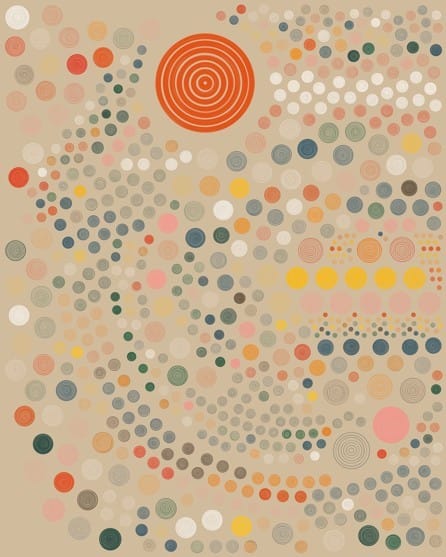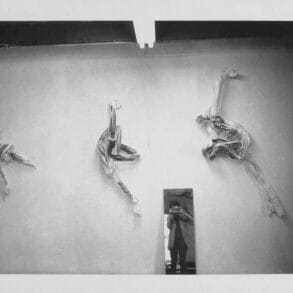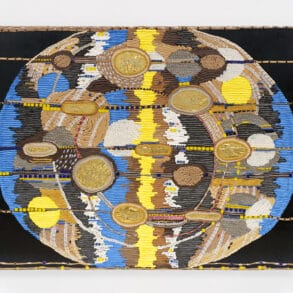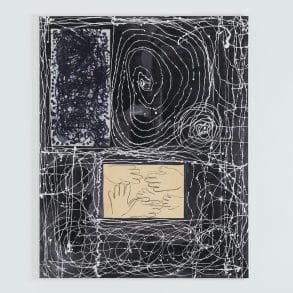New York – Pace Gallery is pleased to announce details of an exhibition of new work by leading generative artist, creative coder, and painter Tyler Hobbs at its 508 West 25th Street gallery in New York. Titled QQL: Analogs and presented under the banner of Pace Verso, the gallery’s web3 hub, this show—on view from March 30 to April 22— will feature large-scale paintings based on Hobbs’ own experimentations with the new QQL NFT algorithm he developed in collaboration with fellow generative artist Dandelion Wist. QQL: Analogs will mark Pace’s first exhibition dedicated to an individual artist’s web3 project.
Hobbs—who is known for his virtuosic work in computational aesthetics—utilizes algorithms, mechanical plotters, and paint in his practice. One of his most acclaimed projects is the Fidenza NFT series, which was presented on the generative art platform Art Blocks, a partner of Pace Verso since 2022. Fidenza is widely regarded as a landmark generative art project, ushering in a new level of code complexity and compositional structure within generative and digital art. The artist’s work has been influenced as much by figures like Sol LeWitt and Agnes Martin—whose methodical approaches to art making, mathematically-minded compositions, and other contributions to Minimalism and Conceptualism influenced the rise of generative art in the mid 20th century—as the ever-expanding technological landscape. Hobbs, who studied Computer Science at the University of Texas, Austin, has exhibited at NFT.NYC; Art Dubai; the Seattle Art Fair; Bright Moments Gallery in New York; Unit London; and other international events and venues. His work has also figured in auctions by Sotheby’s, Christie’s, and Phillips.
Through the QQL project, Hobbs invites collectors to become co-creators of generative art NFTs in an innovative and collaborative process that harnesses the power of unpredictability and happenstance in web3. In September 2022, QQL launched a dedicated website, accessible at qql.art, that serves as a space for intuitive play where visitors can experiment with generating NFTs through Hobbs’ algorithm, using various bespoke tools that encourage interplay between elements of control and chance. Density, flow, and scale are among the mutable attributes that can be manipulated to explore a huge range of formal possibilities generated by the algorithm. Since it went live, the QQL website has seen 21.5 million QQL outputs from users around the world.
Hobbs’ forthcoming exhibition with Pace in New York—coinciding with the 2023 edition of NFT.NYC—will showcase 12 large-scale paintings that are physical representations of the artist’s own QQL outputs. Created using a combination of traditional painting techniques and robotic tools, including a plotter adapted with mechanical customizations by the artist himself, these works reflect enactments of both chaos and order, foregrounding the vast possibilities of systematic approaches to art making. As part of a process that unites programmed digital
equipment with the human touch, Hobbs feeds code through the plotter to forge his compositions and then refines details by hand directly on the canvases. His resulting works feature a wide spectrum of visual effects, forms, and moods, from minimal to maximal and contemplative to exuberant.
While Hobbs’ paintings are derived from the QQL algorithm, they are also unique artworks in their own right, bearing aesthetic traces of both the machine and the artist’s paint strokes. Hobbs’ methodology for these works aligns with his deep interest in system-based artistic practices from the past century—in particular, the work of LeWitt, Martin, John Cage, Richard Diebenkorn, and Bridget Riley.
QQL: Analogs will be accompanied by an online exhibition—presented by Pace—that brings together QQLs minted by artists within and beyond the gallery’s program. Further details about this presentation will be released in the coming weeks.
Pace’s presentation of QQL: Analogs will coincide with Hobbs’ debut UK exhibition, Mechanical Hand, on view at Unit London from March 7 to April 6 and featuring new and recent paintings on canvas and drawings on paper by the artist. Revealing an intimate, contemplative side to his varied practice, Hobbs’ Unit London show meditates on synergistic relationships between humans and machines, focusing on the imaginative possibilities of these exchanges.
The artist’s complementary exhibitions in London and New York will shed light on his distinctive approach to abstraction: while Unit London’s show will offer a holistic view of the artist’s expansive formal experimentations in painting and drawing, Pace’s presentation will spotlight a new, singular body of work derived from his innovative QQL algorithm. Together, the two shows will mark an important moment in Hobbs’ career, showcasing the breadth of the artist’s practice as well as his deep and longstanding interest in system-based art making.
As the first major international art gallery to accept cryptocurrency for both digital and physical artworks, Pace made an early commitment to web3. With Pace Verso, the gallery builds on its 60-year history of innovation and ongoing support of artists who have cultivated advanced studio practices engaged with new technologies. Pace Verso has presented NFT projects by Jeff Koons, Tara Donovan, Loie Hollowell, John Gerrard, A.A. Murakami, Zhang Huan, Glenn Kaino, DRIFT, Lucas Samaras, and other artists in its first year, during which Pace Verso also launched a dedicated Discord server to directly engage web3 communities.
To learn more about Pace Verso, please visit www.pacegallery.com/pace-verso.
Pace is a leading international art gallery representing some of the most influential contemporary artists and estates from the past century, holding decades-long relationships with Alexander Calder, Jean Dubuffet, Barbara Hepworth, Agnes Martin, Louise Nevelson, and Mark Rothko. Pace enjoys a unique U.S. heritage spanning East and West coasts through its early support of artists central to the Abstract Expressionist and Light and Space movements.
Since its founding by Arne Glimcher in 1960, Pace has developed a distinguished legacy as an artist-first gallery that mounts seminal historical and contemporary exhibitions. Under the current leadership of President and CEO Marc Glimcher, Pace continues to support its artists and share their visionary work with audiences worldwide by remaining at the forefront of innovation. Now in its seventh decade, the gallery advances its mission through a robust global program—comprising exhibitions, artist projects, public installations, institutional collaborations, performances, and interdisciplinary projects. Pace has a legacy in art bookmaking and has published over five hundred titles in close collaboration with artists, with a focus on original scholarship and on introducing new voices to the art historical canon.
The gallery has also spearheaded explorations into the intersection of art and technology through its new business models, exhibition interpretation tools, and representation of artists cultivating advanced studio practices. As part of its commitment to technologically engaged artists within and beyond its program, Pace launched a hub for its web3 activity, Pace Verso, in November 2021.
Today, Pace has nine locations worldwide, including a European foothold in London and Geneva, and two galleries in New York—its headquarters at 540 West 25th Street, which welcomed almost 120,000 visitors and programmed 20 shows in its first six months, and an adjacent 8,000 sq. ft. exhibition space at 510 West 25th Street. Pace’s long and pioneering history in California includes a gallery in Palo Alto, which operated from 2016 to 2022. Pace’s engagement with Silicon Valley’s technology industry has had a lasting impact on the gallery at a global level, accelerating its initiatives connecting art and technology as well as its work with experiential artists. Pace consolidated its West Coast activity through its flagship in Los Angeles, which opened in 2022. Pace was one of the first international galleries to establish outposts in Asia, where it operates permanent gallery spaces in Hong Kong and Seoul, as well as an office and viewing room in Beijing. Pace’s satellite exhibition spaces in East Hampton and Palm Beach present continued programming on a seasonal basis.
Pace Verso is Pace Gallery’s hub for web3 projects, launched in 2021 under the leadership of Pace President and CEO Marc Glimcher. Pace Verso works closely with artists within and beyond the gallery’s program to incubate, develop, and realize their web3 projects, operating an NFT platform on the Ethereum blockchain at www.pacegallery.com/pace-verso. In addition to releasing independent projects, Pace Verso frequently collaborates with leading web3 platforms to share artists’ work with wide audiences. In 2022, Pace Verso established a multifaceted partnership with Art Blocks, the leading generative art platform, encompassing boundary-pushing generative NFT releases by Pace’s artists as well as crypto-native artists, exhibitions, and community programming. In its first year, Pace Verso—which reflects the gallery’s longtime and ongoing support of innovative artists who have cultivated advanced studio practices engaged with boundary-pushing technologies—has presented NFT projects by Jeff Koons, Zhang Huan, Glenn Kaino, DRIFT, Lucas Samaras, and other artists. Pace Verso has also grown a robust following on its dedicated Discord server, directly engaging web3 communities through discussions with artists and leaders in the crypto space.






